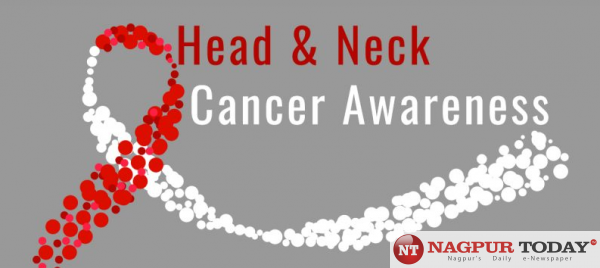
Oral cancer and cancers of Head and neck region are very common in India. Oral cancer is the menacing problem in India because of the prevalence of tobacco addiction in various forms. April is observed as Oral, head and neck cancer awareness month. In this article we shall discuss about this problem and know solutions to it. Oral cancer means cancer of the oral cavity which includes sub-sites namely lip, tongue, buccal or cheek mucosa, mucosa around gums, floor of mouth and hard palate.
Head and neck cancers includes other sites apart from oral cancer which are cancers of nasal cavity, nasopharynx, oropharynx, larynx( Voice box) , hypopharynx, salivary glands, neck lymph nodes and other miscellaneous cancers. Cancer is a state in which normal cells of the body undergo transformation due to various triggers and behave abnormally to multiply rapidly to form tumor. Cells are smallest functional unit of any organ. Cells form tissues and tissues form organs. Tumor then produce signs and symptoms and disrupts normal function of the organ causing disability. Cancer is a peculiar disease because if not treated in time this tumor can then spread to other organ systems and cause death. Cancer is now becoming the leading cause of death. Symptoms of head and neck cancer includes ulcer or growth over lips, tongue or mucosa inside oral cavity, pain and bleeding from ulcer or growth, loose tooth, Pain/ difficulty while swallowing, change or hoarseness in voice, ear pain and lump in neck .
Sometimes precancerous changes like red or white patch inside mouth, difficulty in opening mouth appear before development of cancer. Tobacco consumption is the major risk factor or the development of oral and head and neck cancer. Tobacco chewing in the form of gutkha, kharra, khaini or application of masheri to gums is responsible for oral cavity cancer. Smoking is the most common risk factor laryngeal cancer. Alcoholconsumption is also responsible for head and neck cancer. Tobacco and alcohol contains many carcinogens- cancer inducing agents causing cancer. Some stains of Human papilloma virus (HPV) is responsible for oropharyngeal cancer while Epstein- barr (EBV) virus infection is the risk factor for development of nasopharyngeal cancer.
Prolonged exposure to sunlight is the risk factor for lip and skin cancer. Poor oral and dental hygiene is also a risk factor. Avoiding consumption of tobacco ( in any form ) and alcohol is the best strategy for prevention of head and neck cancer. HPV vaccine is now available for the prevention of HPV associated oropharyngeal cancer. Maintenance of good oral hygiene and avoiding ill fitting dentures is required for prevention. Prolonged exposure to sunlight should be avoided and sunscreen with adequate sun protection factor (SPF) should be used. It should be noted that Head and neck cancer can be easily prevented by the above mentioned strategies. . Head and neck cancer are suitable for early detection but in spite of that many of the patients present with the advanced stage of the cancer. Clinical examination is required for the detection of head and neck cancer which involves inspection and palpation of oral cavity and oropharynx. It may also include examination of different anatomic structures in head and neck region using light source containing scopes/ instruments. In some cases Examination under anaesthesia (EUA) is done for thourough mapping of the disease. Biopsy should be taken from the suspicious lesion to establish the diagnosis of cancer using histopathology examination.
Sometimes Fine needle aspiration cytology FNAC examination is done for diagnosis. Imaging studies are used to know the extent of disease and stage of the cancer which may include Ultrasonography USG, CT , MRI and PETCT. HPV testing should be performed in oropharyngeal cancer to detect HPV associated oropharyngeal cancers which are
sensitive to radiation and chemotherapy and have a good prognosis. It is mandatory to establish diagnosis and get the idea of stage of the cancer before making treatment plan.
Treatment plan for each and every cancer patient should be made by the team of experts including Surgical oncologist, Radiation Oncologist, Medical oncologist, Radiologist and pathologist. It has been proven that outcomes of cancer treatment are much better when treatment plans and made and executed by the team of oncologists in a specialized cancer care centre. Surgery , radiotherapy, chemotherapy or their combinations are required for the effective treatment of head and neck cancer. Surgery involves use of a scalpel for the excision of tumor and removal of lymph nodes in the neck sometimes. Radiotherapy utilises energy from X rays targeted towards cancerous region for the destruction of cancer cells. Energy from X rays brings about DNA damage in cancerous cells causing
death of cancerous cells to cure cancer. Surgery is the main treatment for oral cavity cancer. Radiotherapy is the definitive treatment modality for oropharyngal, nasopharyngeal, Laryngeal ( voice box), hypopharyngeal, nasal cavity cancers and Carcinoma of unknown primary (CUP) with neck nodes. Radiotherapy is the treatment of choice for above mentioned cancers because of its potential of organ preservation and inaccessibility of these sites for surgery or both. In surgery involved organ/ part needs to be sacrificed partially or completely thereby causing loss of function of organ causing morbidity and disfigurement. Radiotherapy is a noninvasive treatment in which organ remains intact and thus function of the organ is preserved causing less morbidity.
Radiotherapy helps in preserving voice function, speech and swallowing function. Radiotherapy can be used as definitive treatment in oral cavity cancers also. Radiotherapy is a treatment of choice in cases which are inoperable due to comorbidities and other medical condditions. Sometimes radiotherapy is used as adjuvant
( supportive) treatment to surgery where it is utilised to treat residual/ microscopic disease after surgery. Radiotherapy treatment is performed on a machine called linear accelerator which has a couch on which patient lie down for 5- 10 minutes wearing a comfortable immobilization device called thermoplastic masks so that patient does not move during the procedure and radiation beams are accurately directed towards target region on the body. Radiotherapy treatment can be made more precise and accurate using on board imaging device like cone beam CT which takes CT images of the target region on couch of a linear accelerator daily known as image guided radiotherapy IGRT. Complications of radiotherapy in the modern era of IMRT and IGRT are less and radiotherapy
treatment is tolerated with good compliance. Chemotherapy is a treatment modality in which drugs are administered in blood through veins.
Some chemotherapy drugs are taken orally. Chemotherapy is used for its radiosensitizing property during
radiotherapy. Radiosensitization means chemotherapy enhances the effect of radiotherpy. Sometimes chemotherapy is used to shrink the tumor before the surgery known as neo adjuvant chemotherapy. Immunotherapy is a new treatment technique in which immune system altering agents are administered to fight cancer. In very advanced stages of cancer and metastatic cancers radiotherapy, chemotherapy, immunotherpy or their combinations are used for palliation of symptoms, prolong life and improve the quality of life. Cancer care also involves Nutritionist and Experts in Physiotherapy and Occupational therapy to improve patient’s quality of life.
In essence oral cavity and head and neck cancer is preventable, suitable for early detection and can be cured with modern treatment techniques without significant toxicity. Public awareness can help to identify cancer in early stages and reduce burden of morbidity and mortality due to oral and head andneck cancer.















